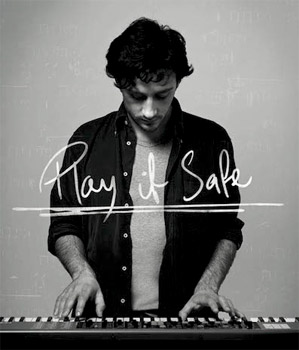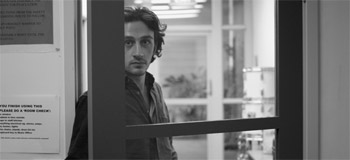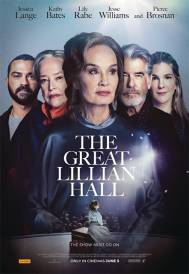Maya Aleksandra Play It Safe

Maya Aleksandra Play It Safe
Cast: Nicholas Kato, Maya Aleksandra, Christine Lui, Alasdair Tremblay-Birchall, Clayton Jacobson
Director: Chris Pahlow
Running Time: 85 minutes
Synopsis: Play It Safe is the debut feature film from Melbourne-based writer/director Chris Pahlow. The film stars Nicholas Kato as Jamie, a 26-year-old musician who is out of work and down on his luck. When Jamie's band breaks up, he's left with no money, no career and no girlfriend. Now he teaches piano at a soul-destroying music school.Will he take a risk and follow his dreams? Or will he surrender to his new-found unhappiness and play it safe?
Play It Safe
Release Date: September 10th, 2015
About The Production
Following in the footsteps of filmmakers like Andrew Bujalski, Lena Dunham, Noah Baumbach, and the Duplass Brothers, Play It Safe explores a generation caught between endless opportunity and the pressures of conformity. The film features unobtrusive black and white camerawork, naturalistic dialog, and unaffected performances. The result is an engaging, refreshing look at twenty-something life filled with authentic emotion, humour, and pathos.
In many ways Play It Safe is a love letter to Melbourne's music scene, and the soundtrack features music from over twenty incredible Melbourne-based acts, including: Big Scary, Mantra & Nathan Liow, Lower Spectrum, Speed Painters, Brothers Hand Mirror, Ron Rude, Aaron Choulai, Polo Club, Aoi, DOS4GW, Yes/No/Maybe, Patinka Cha Cha, Dyl Thomas & Must, Spacecadet Lullabies, Merc Swazey X Nettsmoney, Villains, Gus Rigby.
 Director's Statement
Director's Statement
In 2006 I saw Andrew Bujalski's second film Mutual Appreciation at the Melbourne International Film Festival. I left the screening irrevocably changed. I'd never seen a film like it before. Even though the story took place on a different continent and the characters spoke in different accents, I could relate intimately to what I was seeing on screen, more so than with any Australian film I had seen before. Outside the theatre, I asked my friend Maia: 'Why doesn't someone make a film like this in Melbourne? A film made outside the system, where the characters talk and act just like the people we know in real life?" A few years later I decided to do just that.
Play It Safe explores a generation caught between endless opportunity and the pressures of conformity. It comes from the experiences of myself and other young people trying to figure out how they can pursue all the passions and dreams that Hollywood tells us we deserve, while balancing the responsibilities and realities that come with adulthood. This film is my attempt at capturing an authentic look at twentysomething life and all the awkwardness, humour, and anxiety that comes with it.
Stylistically, Play It Safe is inspired by the films of Ang Lee, Richard Linklater, Mike Leigh, the Mumblecore movement, and of course Andrew Bujalski. I wanted every aspect of the film - from the performances to the production design - to be as authentic and believable as possible, and a restrained use of cinematic devices were key in bringing this to life.
Both characters and dialogue were developed in collaboration with the cast (comprised of both trained and nonprofessional actors). Using a scriptment as a starting point, each scene was workshopped and rehearsed extensively through improvisation to get to the truth of each character and their behaviour. This process continued on set, as I encouraged the actors to surprise me and each other with each take. Play It Safe's entire production process (including filming with multiple cameras) was built around capturing these real moments. Coverage was deliberately restrained to a very limited number of setups per scene, both in an attempt to make the cinematography less obvious and intrusive, as well as to allow us as much time as possible to focus on the performances. Visually, the one notable exception to this emphasis on naturalism was the decision to present the film in black and white. While practically beneficial (a la Kevin Smith's Clerks) this was primarily philosophically motivated (a la the work of Jean Baudrillard) as an acknowledgement of the artificiality nature of film (even extremely naturalistic film), as well as an affectionate nod to the history of this style of filmmaking (which goes all the way back to John Cassavetes' Shadows).
The Melbourne music scene is central to Play It Safe's story, and the film's soundtrack is one of its most important elements. While Play It Safe does not include a score, it diegetically employs more than twenty tracks from local Melbourne musicians: ranging in genres from indie rock & pop, hiphop, house, electronica, and contemporary jazz. Coming from a background in music videos, developing Play It Safe's soundtrack was uniquely challenging and stimulating. With music videos and traditional narrative cinema, the goal may ostensibly be to create the perfect combination of story, visuals, and sound, with all elements working in concert. For an extremely naturalistic film like Play It Safe, this approach was not appropriate. My music supervisor and I would often find songs that were too perfect for a scene, where the movement of the music matched the emotional development of the scene so beautifully that it would completely shatter the illusion of realism. The challenge then was to find songs that would place the film both in space and time, while subtly enhancing the viewer's emotional experience of the scene, all without revealing the film's artifice.
Creating Play It Safe has been a completely life changing experience. I started this project feeling like an outsider. As far as I knew, I was the only filmmaker in Melbourne interested in telling stories like this, in this way. However, since I first commenced developing the screenplay, I have been lucky enough to meet a number of locals filmmakers on this same path, interested in telling different Australian stories, without the need for approval from the Australian film establishment. I feel extremely excited and honoured to be part of this new wave of Australian cinema.
Play It Safe
Release Date: September 10th, 2015
MORE
- Mission: Impossible Fallout
- Glenn Close The Wife
- Allison Chhorn Stanley's Mouth Interview
- Benicio Del Toro Sicario: Day of the Soldado
- Dame Judi Dench Tea With The Dames
- Sandra Bullock Ocean's 8
- Chris Pratt Jurassic World: Fallen Kingdom
- Claudia Sangiorgi Dalimore and Michelle Grace...
- Rachel McAdams Disobedience Interview
- Sebastián Lelio and Alessandro Nivola...
- Perri Cummings Trench Interview



